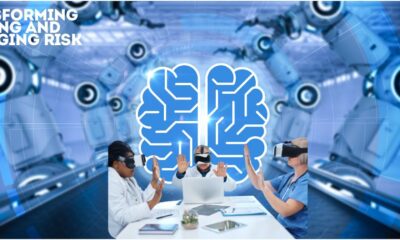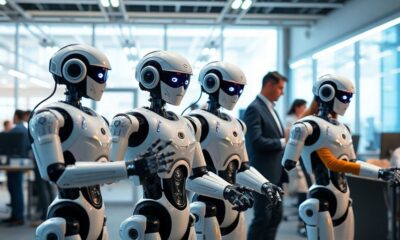Innovations
Top 10 Ways AI Is Making Web Design Easier: Revolutionizing Creativity and Efficiency
Web design has traditionally been a complex and time-consuming process that requires a blend of creativity, technical expertise, and an understanding of user experience (UX) principles. However, the advent of Artificial Intelligence (AI) has transformed this field, making web design more accessible, efficient, and innovative. AI is now a powerful tool that not only enhances the creativity of web designers but also automates various aspects of the design process, leading to faster development cycles and improved user experiences. In this article, we explore the top 10 ways AI is making web design easier and revolutionizing the industry.
1. Automated Design Tools and Website Builders
One of the most significant impacts of AI on web design is the development of automated design tools and website builders. These AI-powered platforms enable users, even those with little to no design experience, to create professional-looking websites quickly and efficiently.
How It Works
AI-driven website builders, such as Wix ADI (Artificial Design Intelligence) and Bookmark’s AiDA (Artificial Intelligence Design Assistant), use algorithms to analyze user inputs and automatically generate website layouts. These tools ask users a series of questions about their business, design preferences, and desired features. Based on the responses, the AI generates a fully functional website with appropriate colors, fonts, images, and content structure.
For example, a small business owner can use Wix ADI to create a website by simply providing information about their industry, preferred style, and content needs. The AI then creates a custom website, complete with relevant images, text, and a responsive design, all in a matter of minutes.
Benefits
- Ease of Use: Automated design tools make it easy for anyone, regardless of their technical skills, to create a website.
- Speed: AI significantly reduces the time required to design and launch a website, allowing businesses to establish an online presence quickly.
- Customization: Despite the automation, these tools offer a degree of customization, enabling users to tweak the design to better fit their brand identity.
2. AI-Driven User Experience (UX) Optimization
User experience is a critical factor in web design, as it directly influences how users interact with a website and whether they convert into customers. AI is playing a crucial role in optimizing UX by analyzing user behavior and making data-driven design adjustments.
How It Works
AI tools such as Google Analytics and Hotjar collect and analyze user data to understand how visitors interact with a website. These tools can identify patterns in user behavior, such as which pages have the highest bounce rates, where users drop off during the conversion process, and which elements attract the most attention. Based on this data, AI can suggest changes to improve UX, such as altering the layout, adjusting the placement of call-to-action buttons, or streamlining the navigation.
For instance, AI might detect that users frequently abandon a shopping cart at a particular step in the checkout process. The AI could then recommend simplifying that step or providing additional assistance, such as a chatbot, to guide users through the process.
Benefits
- Improved Conversion Rates: By optimizing the user journey based on data, AI helps increase conversion rates and overall site performance.
- Personalized UX: AI can tailor the user experience to individual visitors, creating a more personalized and engaging interaction.
- Continuous Improvement: AI-driven UX optimization tools continually learn from user behavior, enabling ongoing improvements to the website.
3. AI-Powered Content Creation and Personalization
Content is a vital component of any website, but creating high-quality, relevant content can be a challenging and time-consuming task. AI is transforming content creation by automating the generation of text, images, and videos, as well as personalizing content to meet the needs of individual users.
How It Works
AI-powered content creation tools, such as Copy.ai and Jarvis, use natural language processing (NLP) to generate written content based on user inputs. These tools can create blog posts, product descriptions, headlines, and even entire webpages. For visual content, AI platforms like Canva and Adobe Sensei provide tools for automatically generating and customizing images, graphics, and videos.
In addition to creating content, AI can personalize it for different users. For example, AI algorithms can analyze user data to determine what type of content is most relevant to each visitor. A website might display different homepage content, product recommendations, or articles based on the visitor’s past behavior, preferences, and demographics.
Benefits
- Efficiency: AI automates content creation, significantly reducing the time and effort required to produce high-quality text and visuals.
- Relevance: Personalized content increases user engagement by delivering information that is directly relevant to the visitor’s interests and needs.
- Scalability: AI allows businesses to create and manage large volumes of content, making it easier to scale their digital presence.
4. AI-Powered Design Assistance and Prototyping
AI is enhancing the design process by providing intelligent assistance during the prototyping phase. AI-driven tools can help designers create and iterate on prototypes more quickly, ensuring that the final product meets both aesthetic and functional requirements.
How It Works
AI-powered design tools like Figma and Adobe XD integrate machine learning algorithms that assist designers in creating prototypes. These tools offer features such as smart layout suggestions, automated resizing, and real-time collaboration. AI can also predict how design elements will behave across different devices and screen sizes, allowing designers to create responsive prototypes that work seamlessly on any platform.
For example, if a designer is working on a mobile app prototype, AI can suggest optimal button sizes and placements based on user interaction data. AI can also automatically adjust the prototype layout to fit different screen sizes, ensuring a consistent user experience.
Benefits
- Faster Iteration: AI accelerates the prototyping process by automating repetitive tasks and providing intelligent design suggestions.
- Improved Accuracy: AI helps ensure that prototypes are accurate and responsive, reducing the risk of issues arising during development.
- Collaboration: AI-powered tools facilitate real-time collaboration, allowing designers, developers, and stakeholders to work together seamlessly.
5. AI-Enhanced Accessibility Features
Accessibility is an essential consideration in web design, ensuring that websites are usable by people with disabilities. AI is making it easier for designers to incorporate accessibility features into their websites, helping to create more inclusive online experiences.
How It Works
AI-powered accessibility tools, such as accessiBe and AudioEye, automatically scan websites for potential accessibility issues and provide recommendations for improvements. These tools use AI to analyze factors such as color contrast, font size, and navigational elements, ensuring that the site meets accessibility standards like the Web Content Accessibility Guidelines (WCAG).
In addition to identifying issues, AI can also generate solutions. For instance, AI can automatically adjust color schemes to improve contrast for visually impaired users, generate alt text for images, or provide audio descriptions for video content.
Benefits
- Compliance: AI helps ensure that websites comply with accessibility standards, reducing the risk of legal issues and enhancing user experience for all visitors.
- Inclusivity: By making it easier to implement accessibility features, AI enables designers to create websites that are accessible to a broader audience.
- Automation: AI automates the identification and resolution of accessibility issues, saving time and effort for designers.
6. AI-Driven SEO Optimization
Search engine optimization (SEO) is critical for driving traffic to a website, but it can be a complex and ever-changing field. AI is simplifying SEO by automating the analysis of search trends, keyword optimization, and content strategy.
How It Works
AI-powered SEO tools, such as SEMrush and Moz, use machine learning algorithms to analyze search engine data and provide recommendations for optimizing website content. These tools can identify the most effective keywords, suggest content topics, and analyze competitors’ strategies. AI can also optimize on-page elements like meta tags, headers, and image alt text to improve search engine rankings.
For example, an AI tool might analyze a website’s current content and suggest adding specific keywords or restructuring content to align with the latest search trends. AI can also monitor changes in search engine algorithms and adjust SEO strategies accordingly.
Benefits
- Improved Rankings: AI-driven SEO tools help websites rank higher in search engine results, increasing visibility and traffic.
- Time Savings: Automating keyword research, content analysis, and on-page optimization saves time and effort for web designers and marketers.
- Adaptability: AI keeps up with changes in search engine algorithms, ensuring that SEO strategies remain effective over time.
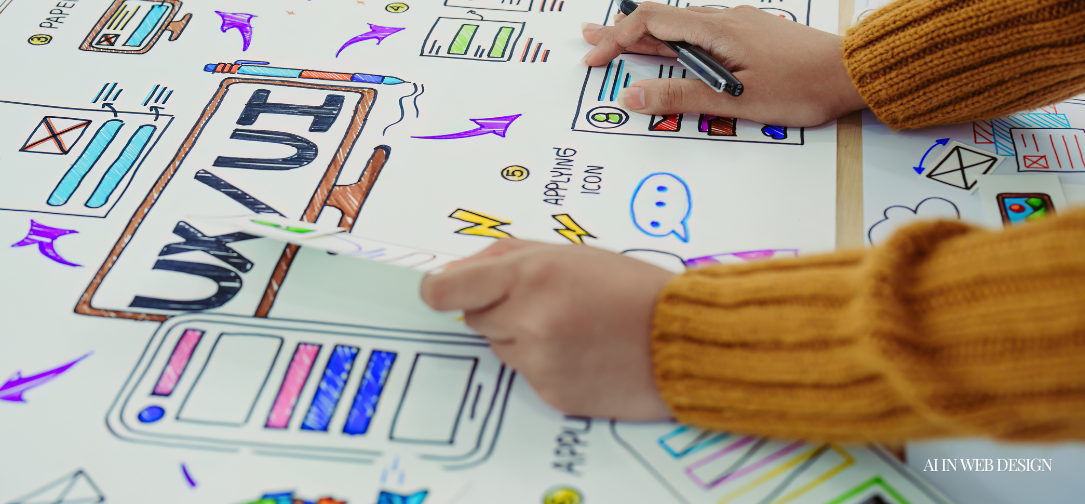
7. AI-Powered A/B Testing and Conversion Rate Optimization (CRO)
A/B testing is a crucial process in web design, allowing designers to compare different versions of a webpage to determine which one performs better. AI is enhancing A/B testing by automating the process and providing deeper insights into user behavior.
How It Works
AI-driven A/B testing tools, such as Optimizely and VWO, use machine learning algorithms to test multiple variations of a webpage simultaneously. These tools analyze user interactions, such as clicks, conversions, and bounce rates, to determine which version of the page performs best. AI can also suggest new variations to test based on user data and past performance.
For instance, an e-commerce website might use AI to test different versions of its product pages, such as variations in layout, call-to-action buttons, or images. The AI system analyzes the results in real-time and recommends the most effective version to implement.
Benefits
- Faster Results: AI accelerates the A/B testing process, providing quick insights into which webpage variations are most effective.
- Data-Driven Decisions: AI provides deeper insights into user behavior, enabling more informed decisions about design and content.
- Higher Conversion Rates: By optimizing webpages based on A/B testing results, AI helps improve conversion rates and overall site performance.
8. AI-Enhanced Design Consistency and Branding
Maintaining consistency across a website is crucial for reinforcing brand identity and ensuring a cohesive user experience. AI is helping designers achieve this by automating the enforcement of design guidelines and branding elements.
How It Works
AI-powered design systems, such as Frontify and Canva’s Brand Kit, allow designers to create and enforce brand guidelines across all digital assets. These systems use AI to automatically apply brand colors, fonts, and logos to website elements, ensuring consistency throughout the site. AI can also detect deviations from brand guidelines and suggest corrections.
For example, a designer working on a corporate website might use an AI-driven design system to ensure that all webpages adhere to the company’s brand guidelines. The AI system would automatically apply the correct color schemes, typography, and imagery, and flag any inconsistencies for review.
Benefits
- Brand Consistency: AI ensures that all design elements are consistent with brand guidelines, reinforcing brand identity across the website.
- Efficiency: Automating the application of branding elements saves time and effort for designers, allowing them to focus on more creative tasks.
- Quality Control: AI-driven systems help maintain high-quality design standards by detecting and correcting inconsistencies.
9. AI-Powered Analytics and Performance Monitoring
Understanding how a website performs is crucial for making informed design decisions and ensuring long-term success. AI-powered analytics tools provide designers with real-time insights into website performance, user behavior, and potential issues.
How It Works
AI-driven analytics platforms, such as Google Analytics and Mixpanel, use machine learning algorithms to analyze website data and provide actionable insights. These tools can track metrics such as page load times, user engagement, conversion rates, and traffic sources. AI can also identify patterns and trends in the data, such as seasonal fluctuations in traffic or emerging user preferences.
For example, an AI tool might detect that a website’s bounce rate increases during certain times of the day and suggest changes to content or layout to address the issue. AI can also monitor the performance of individual pages and recommend optimizations to improve user experience and SEO.
Benefits
- Real-Time Insights: AI provides real-time analytics, allowing designers to make data-driven decisions quickly and effectively.
- Problem Detection: AI can automatically detect performance issues, such as slow load times or high bounce rates, and suggest solutions.
- Continuous Improvement: AI-driven analytics enable ongoing optimization, ensuring that the website continues to perform well over time.
10. AI-Powered Security Enhancements
Website security is a top priority for businesses, as cyber threats continue to evolve and become more sophisticated. AI is playing a crucial role in enhancing website security by detecting and preventing potential threats.
How It Works
AI-driven security tools, such as Darktrace and Cloudflare, use machine learning algorithms to monitor website traffic and detect unusual patterns that may indicate a security threat. These tools can identify and block malicious activities, such as DDoS attacks, SQL injections, and phishing attempts, in real-time. AI can also analyze website vulnerabilities and recommend security patches or updates.
For example, an AI security tool might detect an unusual spike in traffic from a specific IP address and automatically block it to prevent a DDoS attack. AI can also monitor user accounts for suspicious activities, such as multiple failed login attempts, and trigger additional security measures, such as multi-factor authentication.
Benefits
- Proactive Defense: AI detects and prevents security threats in real-time, reducing the risk of data breaches and other cyberattacks.
- Automated Monitoring: AI automates the monitoring of website traffic and user activity, providing continuous protection without the need for manual intervention.
- Vulnerability Management: AI identifies potential vulnerabilities in website code or configuration and recommends corrective actions to enhance security.
Conclusion
Artificial Intelligence is transforming the web design industry by making the design process more efficient, creative, and user-centric. From automated design tools and UX optimization to enhanced content creation and security, AI is revolutionizing how websites are built, maintained, and optimized. These innovations not only make web design easier but also empower designers to create more engaging, accessible, and high-performing websites.
As AI technology continues to evolve, its impact on web design will only grow, offering even more advanced tools and capabilities. By embracing AI, web designers can stay ahead of the curve, delivering cutting-edge digital experiences that meet the needs of today’s users and businesses. The future of web design is undoubtedly AI-driven, and those who harness its potential will be well-positioned to thrive in this dynamic and rapidly changing field.
-

 Press Release7 days ago
Press Release7 days agoCrypto WINNAZ Launches First On-Chain Yield Engine for Meme Coins, Enabling 20x–300x Returns
-

 Press Release4 days ago
Press Release4 days agoBellarium ($BEL) Price Prediction: Could It Hit $5 by 2026?
-
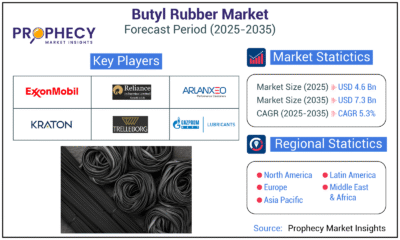
 Press Release1 day ago
Press Release1 day agoClinical Trials Market Set for Robust Growth, Driven by Drug Development Surge and Digital Innovation
-

 Business3 days ago
Business3 days agoHow Managed IT Solutions Help Small Teams Compete at Enterprise Scale
-

 Press Release2 days ago
Press Release2 days agoFill-Finish Pharmaceutical Contract Manufacturing Market Expected to Flourish Amid Biopharmaceutical Boom and Global Outsourcing Trend by 2035
-
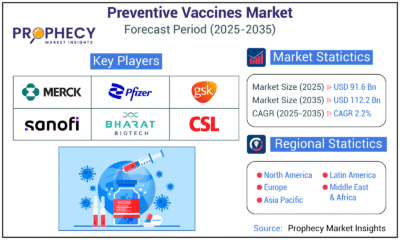
 Press Release2 days ago
Press Release2 days agoPreventive Vaccines Market to Witness Strong Growth by 2035
-

 Press Release2 days ago
Press Release2 days agoGreen Bio Chemicals Market Poised for Sustainable Growth amidst Global Shift to Eco-Friendly Alternatives by 2035
-

 Press Release2 days ago
Press Release2 days agoIndustrial Boiler Market Expected to Surpass USD 24.4 Billion by 2035 Amid Growing Demand for Energy Efficiency and Industrialization


